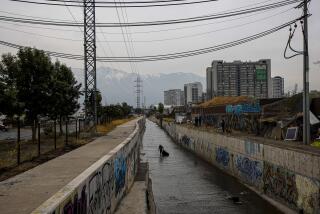What Visitors Should Expect While Traveling Through South America
- Share via
South America is unknown territory to most people in this country, which makes the idea of an independent trip to the continent a daunting prospect. Don’t fret, is my advice. Traveling on your own in South America is only a bit more complicated than exploring Europe--and a lot less expensive these days.
Indeed, seeing South America can sometimes be even more comfortable than traveling in this country. Several of the continent’s domestic airlines offer much more pleasant service--and better food--in coach class than do most U.S. carriers.
Special caution is definitely necessary in parts of South America. Drug trafficking is a problem in Colombia and Bolivia; cholera has spread in Peru and elsewhere in the Andean region, and street crime flourishes in Rio de Janeiro. But the continent is huge and you can travel in reasonable safety in Argentina, Chile, Uruguay, Paraguay, Venezuela and most of Brazil. As in any foreign land, however, unusual procedures or customs can trip an unsuspecting visitor.
Over the years, I have traveled a good deal in South America, and in March took a two-week swing through Argentina, Chile and Paraguay. Along the way, I kept a log of my everyday experiences, good and bad, that may ease the journey of other travelers. If you plan to travel in South America, you can expect:
--Offbeat museum hours. In some South American cities, museums operate on schedules that seem designed to thwart foreign visitors. The problem is particularly acute in Buenos Aires, where no two museums seem to set the same operating days or hours.
Some important ones, such as the Museum of Hispanic-American Art in Buenos Aires, are open only in the late afternoon--from 3 to 7 p.m.--so you have to scramble if you want to take in two or more. My wife and I never did get inside the National Historical Museum on the Plaza de Mayo, which failed to open at the hour posted.
--No extras in your hotel bathroom. None of our hotels--including one five-star property--provided washcloths. Accustomed to this, we pack our own. You should pack shampoo, too, and a shower cap if you use one, since neither was offered in any of our hotels. The only extra that is standard issue, it seems, is bath soap.
On the subject of bathrooms, let me add that few public restrooms--except at airports--provid toilet paper. Carry a small supply with you. And save small coins to tip the restroom custodian.
--Late dining. If you want to eat fashionably in Santiago, Buenos Aires and Rio de Janeiro, don’t plan to show up at good restaurants until 9:30 or 10 p.m. at the earliest. Otherwise, you will eat alone or with other tourists.
Some of the locals bring young children out for late-evening dining, and I spotted more than one youngster dozing as the meal lingered past 11. I know exactly how they felt, but I am too old to lay my head on the table and sleep.
--Good airline service. On my latest trip, I flew on four South American airlines: Lan Chile and Ladeco of Chile; Aerolineas Argentinas of Argentina, and Lineas Aereas Paraguayas (LAP) of Paraguay. All the flights were within South America and all went smoothly. Only one flight was late--by about 20 minutes.
Lan Chile served lunch in coach class on real china. Ladeco spread a napkin across each seat-back table before placing a lunch tray on it, and offered complimentary wine and beer.
You should reconfirm all flights at least 24 hours in advance or your reservation may be canceled. None of the four airlines made advance seat assignments. Seats were assigned on a first-come, first-served basis as passengers arrived at the check-in counter. As a result, most passengers show up early. The airports in Santiago, Buenos Aires, Asuncion, Sao Paulo, Rio and Caracas are clean and comfortable.
We traveled in South America during the Persian Gulf War, and I was alert to security procedures. As far as I could judge, they appeared lax only at the international airport in Asuncion, the capital of Paraguay. The airport had no scanning machine to check hand-carried luggage for our flight to Sao Paulo, Brazil, and we were toting a large bag filled with pottery wrapped in paper. The security officer asked us what was inside, and then waved us on without checking. I hoped no one else was getting through so easily.
--Difficulty cashing traveler’s checks. In two cities in Argentina--Buenos Aires and the Andean resort of Bariloche--we had a bit of a problem exchanging American Express traveler’s checks in U.S. dollars for australs, the Argentinian currency. All banks and most currency exchange offices--which offered the most favorable exchange rates--refused to accept traveler’s checks. They wanted U.S. dollars in cash only.
Each time we tried, we were directed to Casa Piano, the only exchange house we could find in either city that took traveler’s checks. Not surprisingly, the lines were long. In Buenos Aires, the procedure to cash a $100 U.S. check took 90 minutes in a packed room. You can exchange traveler’s checks at your hotel, and merchants will accept them for purchases, but the exchange rate is not as good.
In Paraguay, the foreign-currency booth at the Asuncion airport also refused to exchange traveler’s checks. Instead, I had to exchange one of my last $20 bills to get enough Paraguayan guaranis to pay the taxi fare to our hotel.
The moral here is to carry enough cash--always in favor--to get you through the inevitable tight spots until you can use your traveler’s checks.
--Confusion in calculating exchange rates. Inflation has added lots of zeros to some South American currencies. When we were in Argentina, a U.S. dollar bought 10,000 australs. Coping with what are big numbers for even modest expenses such as lunch and dinner can be confusing.
For example, our dinner for two in Bariloche came to 333,000 australs, or about $33. Initially, I started to leave a tip of 4,000 australs, which seemed a lot but really was less than 50 cents. Fumbling with unfamiliar bills, I quickly boosted the sum to 40,000 australs, about $4--a better tip, but still not the 15% I leave as a minimum at home.
--Salty food. Years ago I lived in Chile, and my Chilean friends who traveled to the United States told me our food was too sweet to their taste. Now that I’ve cut back on sugary treats, I agree with them.
And since I’ve cut back on the use of salt, too, I found meals everywhere we traveled in South America saltier than I prefer. The guidebook I was carrying suggested I advise the waiter to tell the cook sin sal (without salt), but I never remembered until it was too late.
--Bottled drinking water. You can drink tap water in Santiago, but to be on the safe side, plan to drink bottled water wherever you travel. All our hotels had mini-bars stocked with bottled water, but there was never enough of it and it cost about as much as a bottle of beer. We bought bottled water much cheaper at neighborhood grocery stores.
As in this country, bottled mineral water is an acceptably fashionable before-dinner drink at restaurants. You can also linger over mineral water rather than soft drinks, beer or wine at sidewalk cafes. Be sure to order all drinks without ice.
--Modest prices. If you are not traveling deluxe class, South America can be an inexpensive destination--cheaper than the United States and much cheaper than Europe.
In Paraguay, the rate at our old but charming hotel was about $40 a night, which included a large continental breakfast. The most expensive hotel we stayed in, a five-star property in Buenos Aires, charged $150 a night--although we got a discounted rate by buying an air-hotel package.
In Santiago, a thick filet mignon cost about $7. In Buenos Aires, we got steaks that filled the plate for about $12 each. A full dinner for two in Asuncion--grilled chicken or beef--never topped $25.
--Someone helpful who knows English. I speak some Spanish, so perhaps I’m not to be fully trusted when I report that you can negotiate South America’s capital cities without English. My impression, however, is that a lot of people in the tourism industry know enough English to be very helpful. Hotel desk clerks sometimes insisted on speaking English, although I made a point of using my Spanish.
City tours are offered in English, and all four South American airlines provided in-flight information in both English and Spanish and sometimes in German. In Santiago, the museums distribute printed guides to the exhibits in English, but this was not true in Buenos Aires or Asuncion. A siesta shutdown. Plan a long lunch or nap at midday, because most shops, offices and museums shut down for at least an hour or two. In Asuncion, where the summer sun is ferocious and the humidity high, many places close by noon and don’t reopen until 3 or 4 p.m. They remain open, however, until 8 p.m.
--To blunder once in a while. I know better, but I got zapped by a waiter in a fancy Santiago restaurant where we went to celebrate my birthday. The restaurant is recommended highly by all the guidebooks.
I could see as I studied my menu that prices were reasonable: Most entrees cost between $6 and $8, and a bottle of wine was $9. When the waiter suggested an unlisted appetizer of grilled shrimp, we both said yes. He mentioned no price, but how expensive could it be?
For two, the shrimp appetizer came to $37, just about what the entire rest of the meal--entree, dessert, bottled water and wine--cost. I questioned the charge, but the waiter was adamant. Live and learn.
--Quiet weekends in the city. You are not likely to find many shops open on Saturday afternoon or Sunday in South America’s cities. But I have found weekends to be a pleasant time for exploring. The sidewalks are less crowded, and drivers don’t feel compelled to honk their way through the light traffic.
Santiago has made a point of opening its museums on Sunday, and some Buenos Aires museums have Sunday hours also. Parks and plazas are popular gathering places, and you are likely to see mimes and other street performers.
--Limited fire security. We stayed in six hotels--including three high-rises--and I did not see a sprinkler system or smoke alarm in any of them. If you are troubled by the lack of protective devices, make a point of seeking out hotels where they are provided. I always looked for the nearest fire escape.
More to Read
Sign up for The Wild
We’ll help you find the best places to hike, bike and run, as well as the perfect silent spots for meditation and yoga.
You may occasionally receive promotional content from the Los Angeles Times.






